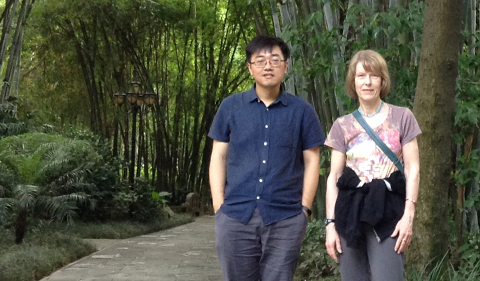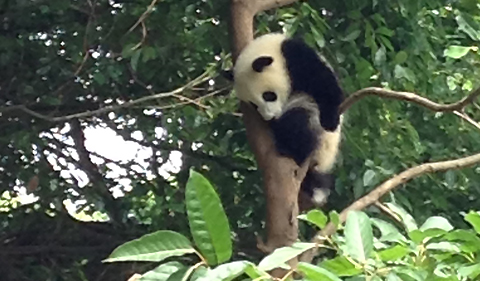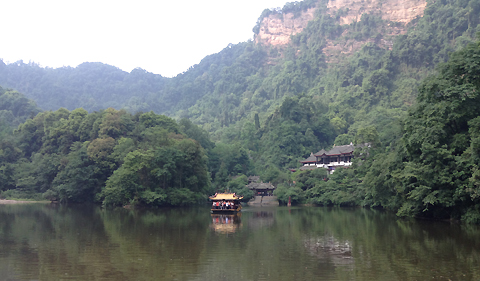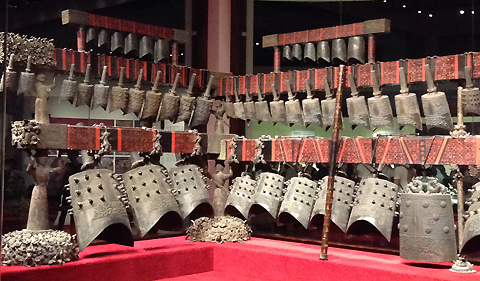
Chen Ji and Charlotte Elster visit a grove of rare bamboo on display at the Wangjiang Pavilion Park, Chengdu, China.
It’s not every week you are given an opportunity to share the latest in nuclear physics research, take time to observe wild pandas in a nature preserve, and admire famous musical instruments from the 5th Century BC.
Recently, nuclear physicist Charlotte Elster traveled to south-central China where she presented her research at a workshop on Theory of Rare Nuclear Decays. The event took place in Chengdu, the capital of Sichuan Province, and was co-sponsored by the China-U.S. Theory Institute for Physics with Exotic Nuclei (CUSTIPEN) and Sichuan University.
Also attending the workshop was OHIO physics alumnus Chen Ji (Ph.D. ’12). Ji is a Chinese national and professor at Central China Normal University in Wuhan, the capital city of central China’s Hubei province. While a doctoral student at OHIO, Ji studied nuclear physics under the direction of physicist Daniel Phillips.
Elster presented the progress she and her collaborators have made recently in deuteron-nucleus scattering, while Ji highlighted his work on effective field theory studies of halo nuclei.
“I wanted to share with the attendees that the OHIO-MSU collaboration can now compute Deuteron-Helium-4 scattering,” Elster explains. “And thus we are making steady progress in our project of applying few-body methods to nuclear reactions.”
“Meeting other colleagues of different research backgrounds has a greater potential to exchange ideas in depth,” Elster reflects. “Scientists attend workshops and conferences with the anticipation that through discussion and networking, new research collaborations may develop. As in other fields of study, personal interactions are important for successful research collaboration.”
CUSTIPEN organizers scheduled time at the conference between scientific presentations and discussion for attendees to take breaks, including a stroll through the groves of rare bamboo growing in the adjacent Wangjiang Pavilion Park.

Panda in the tree canopy at the Chengdu Research Base of Giant Panda Breeding (Photo provided by Charlotte Elster)
The conference included an optional excursion to the nearby Chengdu Research Base of Giant Panda Breeding, where scientists study and raise both the popular black and white giant pandas and their raccoon-like red cousins.

Ferry transporting visitors to the Taoist Shrine at the base of Mount Quincheng (Photo provided by Charlotte Elster)
The day-long excursion also took conference participants to Mount Qingcheng and the historic Taoist Shrine, considered one of the birthplaces of Taoism and one of the most important Taoist centers in China.

A chime of bells and set of musical stones were unearthed from the tomb of the Marquis of Zeng (c. 430 BC) in Hubei Province in 1978. The set of bells are from the Chinese bronze culture. (Photo provided by Charlotte Elster)
Later in the week, they visited the Hubei Provincial Museum, which features extensive artifacts from the Tomb of Marquis Yi of Zeng dating around 430 BC during China’s Warring States period. The museum is famous for a large number of ancient musical instruments, including the great set of bells.
“I enjoyed the trip, scientifically and socially,” Elster adds. “And I see potential areas of future scientific exchange with participants from the workshop in Chengdu. Additionally, I was impressed by the breadth of physics research carried out in Ji’s department at Central China Normal University in Wuhan.”



















Comments